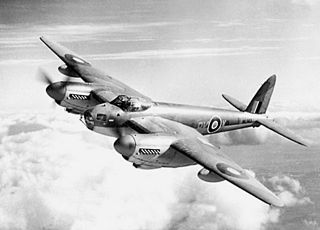No. 695 Squadron RAF was an anti-aircraft co-operation squadron of the Royal Air Force from 1943 to 1949.
No. 679 Squadron RAF was an anti-aircraft co-operation squadron of the Royal Air Force during the Second World War.
No. 639 Squadron RAF was an anti aircraft co-operation squadron of the Royal Air Force from 1943 to 1945.
No. 517 Squadron RAF was a meteorological squadron of the Royal Air Force during the Second World War.

No. 518 Squadron RAF was a meteorological squadron of the Royal Air Force during the Second World War. The weather observations they collected helped inform Group Captain James Martin Stagg's recommendation to General Dwight D. Eisenhower to delay the launching of the D-Day invasion of Normandy from 5 June to 6 June 1944.
No. 520 Squadron RAF was a meteorological squadron of the Royal Air Force during the Second World War.
No. 521 Squadron of the Royal Air Force was a Second World War meteorological observation unit operating from Norfolk.

No. 1300 (Meteorological) Flight was formed on 31 July 1943 at RAF Alipore, West Bengal, British India, by re-designating No. 1 Meteorological Flight RAF. The flight, strength of which had been reduced to three Hawker Hurricane Mk.IIs by this time, was disbanded on 30 May 1946 at RAF Kallang, Malaya, as No. 1300 Flight, THUM standing for Temperature and Humidity.
No. 510 Squadron was a Royal Air Force transport and liaison aircraft squadron that operated during the Second World War.
194 Squadron RAF, though formed as a training unit in Egypt and ended as a casualty evacuation unit in Malaya, was for most of its active service life a RAF transport squadron that flew in South East Asia.

No. 1451 (Fighter) Flight was formed at RAF Hunsdon, Hertfordshire on 22 May 1941, equipped with Turbinlite Douglas Boston and Douglas Havoc aircraft. On operations they co-operated at first with Hawker Hurricanes of No. 1422 Flight RAF and later with Hurricanes of 3 Squadron. The flight was replaced with 530 Squadron on 8 September 1942 but officially disbanded as late as 25 January 1943.

No. 1452 (Fighter) Flight was formed at RAF West Malling on 22 May 1941, equipped with Turbinlite Douglas Boston and Douglas Havoc aircraft. On operations they co-operated at first with the Boulton Paul Defiants of 264 Squadron and later with the Hawker Hurricanes of 32 Squadron. The flight was replaced with 531 Squadron on 8 September 1942 but officially disbanded as late as 22 January 1943.

No. 1454 (Fighter) Flight was formed at RAF Colerne, Wiltshire on 27 June 1941, equipped with Turbinlite Douglas Boston and Douglas Havoc aircraft. By 26 January 1942 the flight moved to RAF Charmy Down, Somerset. On operations they co-operated with the Hawker Hurricanes of 87 Squadron, which also flew from Charmy Down. The flight was replaced with 533 Squadron on 8 September 1942 but officially disbanded as late as 31 January 1943.

No. 1455 (Fighter) Flight was formed at RAF Tangmere, West Sussex on 7 July 1941, equipped with Turbinlite Douglas Boston and Douglas Havoc aircraft. On operations they co-operated with the Hawker Hurricanes of 1 Squadron and 3 Squadron. The flight was replaced with 534 Squadron on 2 September 1942.

No. 1456 (Fighter) Flight was formed at RAF Honiley, Warwickshire on 24 November 1941, equipped with Turbinlite Douglas Boston and Douglas Havoc aircraft. On operations they cooperated with the Hawker Hurricanes of 257 Squadron. The flight was replaced with 535 Squadron on 2 September 1942 but officially disbanded as late as 25 January 1943.

No. 1457 (Fighter) Flight was formed at RAF Colerne on 15 September 1941, and was equipped with Turbinlite Douglas Boston and Douglas Havoc aircraft. On operations they cooperated with the Hawker Hurricanes of 247 Squadron. By 15 November 1941 the flight moved to RAF Predannack, Cornwall. During its operational life the flight had three sightings of possible enemy aircraft. The first occasion was on 24 June 1942, when the flight lit up a suspected Ju 88 and the satellite fighters of 247 sqn fired - on a RAF Short Stirling. Others sightings occurred on 27 June and in August, but no enemy aircraft was shot down. The flight was replaced with 536 Squadron on 8 September 1942 but officially disbanded as late as 31 December 1942.

No. 1458 (Fighter) Flight was formed at RAF Middle Wallop on 6 December 1941, from elements of No. 93 Squadron RAF, equipped with Turbinlite Douglas Boston and Douglas Havoc aircraft. On operations they cooperated with the Hawker Hurricanes of 245 Squadron. The flight was replaced with 537 Squadron on 8 September 1942 but only officially disbanded as late as 25 January 1943. 537 Sqn, which had taken over men and machines, carried on flying the Turbinlite Bostons and Havocs till the system was abandoned on 25 January 1943, when Turbinlite squadrons were, due to lack of success on their part and the rapid development of AI radar, thought to be superfluous.

No. 1459 (Fighter) Flight was formed at RAF Hunsdon, Hertfordshire on 20 September 1941, equipped with Turbinlite Douglas Boston and Douglas Havoc aircraft. By 21 September 1941 the flight moved to RAF Hibaldstow, Lincolnshire. On operations they cooperated with the Hawker Hurricanes of 253 Squadron.

No. 1460 (Fighter) Flight was formed at RAF Acklington on 15 December 1941, equipped with Turbinlite Douglas Boston and Douglas Havoc aircraft. The flight became operational in May 1942 and made its first and only contact with the enemy in June of that year. On operations they cooperated first with the Hawker Hurricanes of 43 Squadron and later with those of 1 Squadron. The flight was replaced with 539 Squadron on 2 September 1942 but officially disbanded as late as 23 January 1943.

No. 1303 (Meteorological) Flight was formed at RAF Ratmalana, Ceylon, on 31 July 1943 by re-designating No. 4 Meteorological Flight RAF. The flight was disbanded on 30 April 1946 at RAF Negombo, Ceylon.





